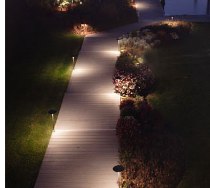Categories: Featured Articles » Sharing experience
Number of views: 15332
Comments on the article: 0
Garden lighting at your site
 Garden lighting design is divided into two areas. The first includes technical issues that are involved Electrical Engineer, and in the second case, the architect determines how organically the technical elements fit into the overall composition of the garden.
Garden lighting design is divided into two areas. The first includes technical issues that are involved Electrical Engineer, and in the second case, the architect determines how organically the technical elements fit into the overall composition of the garden.
When illuminating an open space, the main thing is decorative design and ensuring normal orientation in space. In addition, outdoor lighting is often used to protect and provide traffic.
Types of lighting are divided into technical, decorative, flooding and accompanying. All types are compatible with each other.
There is an easy way to create coverage of the territory is the uniform arrangement of the same type of fixtures. This method is great for lighting alleys, paths, and areas of your garden. Most commonly used floor lamps, the design of which has three fundamental stylizations: high-tech, functional and antique. The effectiveness of their work with competent lighting design does not depend on stylization.
 If you want to outline the contours of the relief or to highlight the direction and shape of the tracks, use marking light. In this case, the lamps are located along the paths, on the sides of the alley or in the middle of a flower bed.
If you want to outline the contours of the relief or to highlight the direction and shape of the tracks, use marking light. In this case, the lamps are located along the paths, on the sides of the alley or in the middle of a flower bed.
To achieve decorative effects, often used highlighting trees and plants. In such a situation, it is possible to use: spotlights built into the ground; floodlights or portable low-power garden lights.
In addition to trees and plants, objects of inanimate nature and small architectural forms can be found in your garden. The best option for lighting them is the use of asymmetric spotlights embedded in the ground.
If your garden is equipped with a pool or a fountain, it is necessary to take into account the fact that for lighting equipment, water is a serious problem, therefore additional requirements are put forward for the safety and reliability of the lamps. Here perhaps the usual flood lightingHowever, from an aesthetic point of view, it looks much prettier, the application underwater lights.
Before you start installing the lighting system, you need to understand the features of your site and, based on them, outline an accurate plan of action.
At the first stage, according to the approved drawing, electromagnet routes are marked. Then, relative to the marking, manual digging of the trenches is performed, while the soil is laid out along the trench for backfilling.

The next step is the laying and communication of wires. The wires are placed in protective sleeves and laid in a trench, while it is necessary to ensure that no foreign objects can get into it, which can cause damage. The main thing is to control the quality and reliability of installation and connection of different cable sections.
Then, according to the specification, the installation and connection of switches and fixtures to the electrical panel is carried out. After the installation is completed, the system is checked and the trenches are backfilled. Thanks to existing technologies, your lawn will be perfectly even 20 days after the completion of work.
See also at bgv.electricianexp.com
:
